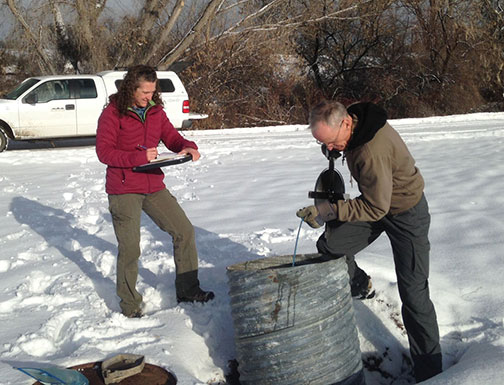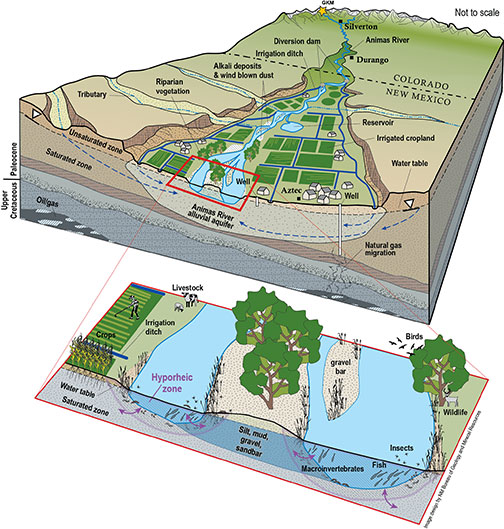Animas River Study Finds No Evidence of Groundwater Contamination from Gold King Mine Spill
November 3, 2020
Continued Monitoring Recommended to ID Areas Vulnerable to Surface Water Pollutants
SOCORRO, NM - A recent study conducted by the New Mexico Bureau of Geology and Mineral Resources found no evidence of groundwater contamination along the Animas River from the 2015 Gold King Mine Spill or historic acid mine drainage in the upper part of the watershed.
“The good news is that the Gold King Mine Spill did not significantly affect groundwater quality in the shallow alluvial aquifer in New Mexico,” said Dr. Talon Newton, Bureau hydrogeologist and lead author. “Under the current geochemical conditions, dissolved metals of concern associated with upstream acid mine drainage will quickly precipitate out of solution.”
 The Gold King Mine Spill released metal and sludge-laden water into Cement Creek near
Silverton, Colo., on August 5, 2015. This water moved downstream into the Animas River
and northern New Mexico. In response, multiple state and federal agencies launched
a collaborative research effort to assess the environmental and economic impacts of
the spill.
The Gold King Mine Spill released metal and sludge-laden water into Cement Creek near
Silverton, Colo., on August 5, 2015. This water moved downstream into the Animas River
and northern New Mexico. In response, multiple state and federal agencies launched
a collaborative research effort to assess the environmental and economic impacts of
the spill.
(Pictured at right are Bureau Hydrogeological Technicians Kitty Pokorny and Scott Christenson measure the depth-to-water in a well near the Animas River.)
An initial study released by the New Mexico Bureau of Geology in 2017 found no evidence for groundwater contamination in the shallow aquifer directly resulting from the Gold King Mine Spill. However, the study found several wells where manganese and iron levels exceeded the Environmental Protection Agency’s secondary maximum contaminant levels, which apply to dissolved constituents that do not effect human health but may influence water taste and appearance. As a result, continued monitoring and additional sampling was recommended to identify sources of dissolved metals and verify the initial model developed for the aquifer system.
 “While these metals are among those of concern that were associated with the Gold
King Mine Spill, we could not with any certainty link the high manganese and iron
water to the spill or legacy acid mine drainage,” Newton said. “Therefore, the main
focuses of the second phase were to identify solute sources and to further examine
controls on redox conditions which appeared to affect iron and manganese concentrations.”
“While these metals are among those of concern that were associated with the Gold
King Mine Spill, we could not with any certainty link the high manganese and iron
water to the spill or legacy acid mine drainage,” Newton said. “Therefore, the main
focuses of the second phase were to identify solute sources and to further examine
controls on redox conditions which appeared to affect iron and manganese concentrations.”
(Pictured at right are conceptual models of the Animas River and shallow aquifer system from the headwaters near Silverton, Colo., to Aztec, N.M.)
The sampling for the second phase of the study occurred in fall 2018 and spring 2019. The samples were analyzed for major chemistry, trace metals, and stable isotopes of oxygen, hydrogen, sulfur, and carbon, which can indicate groundwater recharge locations and water flow paths in the aquifer.
Study results indicate the Animas River is gaining over almost the entire section in New Mexico, meaning groundwater is flowing into the river. Therefore, in most locations, it is unlikely that contaminated river water is moving into the shallow aquifer. The irrigation system presents a more common potential pathway for surface water contaminants to enter the groundwater system.
The iron and manganese detected in some wells are likely coming from already-deposited river sediments in the valley that contain these metals, not from contaminated river water. Iron, manganese, and other metals can be mobilized when geochemical conditions, such as dissolved oxygen levels or pH, change.
Measurements of dissolved oxygen and oxidation-reduction potential (Eh) in some wells indicate there are localized areas where water may be moving from the river, irrigation canals, and agricultural fields into the shallow groundwater aquifer at different times during the year. This could potentially introduce contaminants into the shallow aquifer. By measuring dissolved oxygen and Eh at selected wells repeatedly over time, areas where river and irrigation water is entering the shallow aquifer can be identified and monitored for contaminants.
“Our results show that the shallow aquifer is a very dynamic system from a geochemical perspective, and if geochemical conditions change enough, acid mine drainage issues at the Animas Headwaters could present potential risks to the quality of the shallow groundwater in New Mexico,” said Newton.
Results also indicate that sulfate-rich water is likely entering the shallow aquifer from deeper aquifers in the underlying sedimentary rocks. The specific source of this water and the flow path it takes into the shallow aquifer remains a mystery.
“While the additional data collected for the second phase largely confirmed our hydrogeologic conceptual model, unsurprisingly, more data showed the system to be more complex and generated more questions,” said Newton. “We highly recommend the continued monitoring of groundwater quality in the Animas Valley in New Mexico.”
The New Mexico Bureau of Geology and Mineral Resources is a non-regulatory research and service division of New Mexico Tech in Socorro. For 93 years, the Bureau has served as the geological survey for the state of New Mexico.
– NMT –